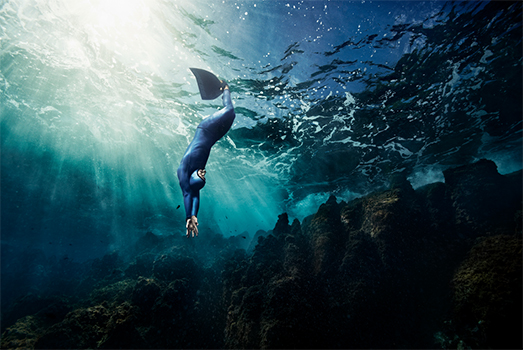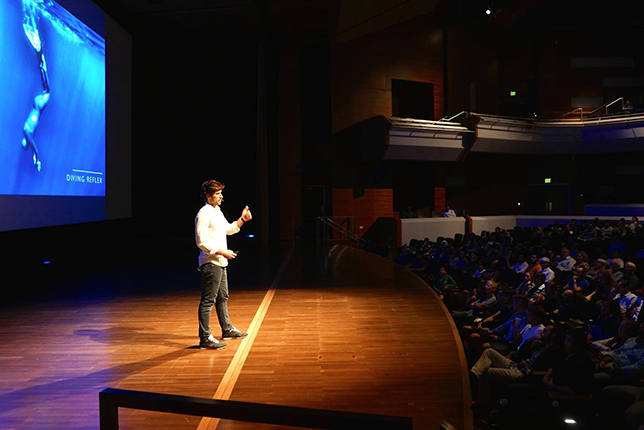WEP 2015: Freediver Guillaume Néry on pushing human limits under water

Guillaume Néry freediving. Photographer Ian Derry.
“You just have to know that in the fifties the doctors and the scientists predicted there was a limit for the human body in the watery depths on a single breath. And this limit, as the doctors were saying, was 50 meters,” French free diving champion Guillaume Néry told the audience at his Winter Enrichment Program (WEP) keynote address at KAUST. Fast-forward to today and Néry, who beat the world record three times in his career, is able to dive to a depth of 125 meters – while holding his breath for up to seven minutes and forty-two seconds.
The 32-year-old freediver recounted how he discovered his calling in a school bus back when he was around 15 years old. “I was with a friend and we were playing a game to see who could hold his breath the longest. I lost. And because I lost I decided to train at home in my bedroom,” Néry recalled. Before long, he was able to hold his breath from four to five minutes. Five years later, at 20 years old, he established his first world record by diving down to a distance of 87 meters. He became world champion in 2011 and achieved his deepest dive of 125 meters in Greece in 2013.
So what is freediving? A fast growing sport, freediving is trying to hold your breath for as long as possible. It’s also a regulated sport, through AIDA International, comprising of both sea and pool disciplines. Within the area that Guillaume Néry focuses on, sea diving, there are several sub-categories including: Constant Weight Apnea and No Limit Apnea. Unlike the No Limit Apnea discipline, where the diver descends without physical effort using a weighed sled and ascends with an inflatable balloon, Néry’s Constant Weight Apnea discipline is done entirely unassisted and with only the use of bifins or a monofin.
As Néry acknowledges, other divers, such as Static Apnea divers within the pool disciplines, are able to hold their breath under water for much longer than he can. Another discipline, Static Apnea, measures the longest distance a swimmer can go in a pool on a single breath of air. But Néry has gained his notoriety for diving into the depth of the ocean unaided, through both the descent and ascent, and swimming down using only a wetsuit and a monofin.
Diving Into Another World
“One of my passions is to explore and redefine my own limit and the limit of the human body,” Néry explained. He considers freediving as an exploration of the body and the mind. But in order to succeed he must change his mode of thinking when faced with the deep ocean’s environment. The common and logical reflex human beings have on earth when met with resistance is to fight or struggle against it. And that’s exactly what one has to avoid when we going into the deep.

Guillaume Néry speaking at WEP 2015.
After reaching the 50-meter mark on a dive, Néry explains that the pressure can be felt. “When you first experience this feeling of pressure it feels quite strange and you want to resist. You want to go against it and you contract the chest. You think: Okay, if I contract I will be stronger than the pressure. But no, there’s nothing that can be stronger than the water and the pressure,” he said. “The only way to be accepted by the depths and by the elements, by the pressure, is to let go.”
In fact, humans still have an uncanny link with marine mammals because of how our body adapts to deep water environments. “This is the miracle of nature … we still have deep inside of us a little dolphin sleeping which emerges as soon as you put your face in the water,” said Néry.
Blood Shift
As soon as Néry leaves the surface and starts swimming down, his heartbeat decreases and his blood circulation changes. We all have microvessels in our extremities (toes, hands, feet, arms, and legs) which constrict and send out blood to the vital parts of our bodies – where oxygen is most needed.
This drop in the heartbeat and the vessel constriction is called the mammalian diving reflex. “The heartbeat decreases and goes to around 30 beats per minute … Even though I’m swimming, even though I’m doing a big effort, the heartbeat stays very low in order to save oxygen,” Néry explained.
At that stage, Néry simply focuses on being relaxed and actually stops swimming. “It’s the best moment of the dive because I can just rest from 30 meters to 125 meters,” he says. He can stop swimming at that point because that’s when all the pressure leaves his extremities and switches to the empty (or non-compressible) parts of the body; mainly his lungs. Essentially, after 30 meters, his body is heavier and can start sinking like a rock.
What scientists didn’t understand before, when they thought that humans could not dive deeper than 50 meters, is a phenomenon called blood shift.
It was believed that the maximum depth at which human lungs can compress is at 50 meters – otherwise they would implode. Blood shift is a miracle of nature that we share with marine mammals that allows for the formation of an increasingly thickening blood plasma layer around the lungs which is basically meant to protect us from the mounting water pressure. “It’s not something I control. It’s mechanical. When you reach a certain volume, blood shift happens. So it’s magic and it allows me to keep going,” Néry said.
The importance of Preparation
Despite being helped by this natural phenomenon, Guillaume Néry still places a huge importance on his physical training and conditioning. “I feel confident. I am confident in my mind. Why? Because of all the physical training I’m doing all year long. And I’m training all year long. Training is a big part of my life and that is the main reason why I’m confident,” he said.
His daily training regimen includes yoga and breathing exercises in order to have maximum flexibility in the chest and in the diaphragm. Néry also does a lot of muscle training to gain the necessary power and efficiency for freediving.
At the end of the day, he wants to come back to the surface alive. So his extensive preparation allows him to reduce the risks. As he describes it: “I’m a human, I’m not a fish, and I’m not a marine mammal. Even the marine mammals need to breathe but fish live in the water. I have to breathe on land so I’m happy [to be back at the surface every time]. I’m happy to breathe and feel these small molecules of air going through my lungs. … It’s like a rebirth because I learned so much on a deep dive.”
- by Meres J. Weche, KAUST News

